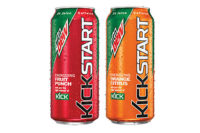![]()
The gender gap
Beverage ingredients target men's, women's health needs
BY Elizabeth Brewster
In the race for beverages
fortified with healthy ingredients, women are miles ahead of men when it
comes to knowing what's good for them — and consuming it.
"Women are typically more open to healthy ingredients, and they're
usually early adopters of healthy ingredients," says Lee Knudson, product manager
for AdvantaSoy at Cargill Health & Food Technologies, Minneapolis. "But as the
wave of awareness continues in health-type products, men will start to become
more involved."
Sharon Rokosh, market development specialist for Purac America
Inc. in Lincolnshire, Ill., agrees that women have the edge right now in healthy-beverage
marketing. "Women's health gets such tremendous media coverage and research
dollars, plus women are typically very receptive to trying functional, value-added
products," Rokosh says.
Most industry observers say they see a growing market
for beverages catering to the health needs of both men and women as
researchers continue to refine the science behind health claims for such
gender-specific concerns as osteoporosis and prostate cancer. However,
mainstream beverage products labeled specifically for men or women, such as
Baxter International's Pulse water in Men's and Women's
formulas, are still few and far between.
"Women and men have different nutrient deficiencies and health
concerns and are looking for beverages that deliver individualized benefits,"
says Robert Bailey, marketing manager for DSM Nutritional Products Inc., Parsippany,
N.J. "Beverage is still the No. 1 platform for delivering nutrition, and this
will continue to trend upward with functional food growth."
At the top of the beverage ingredient list for both sexes, say
industry observers, is soy.
Soy savvy
Thanks to veggie burgers, soy is becoming trendy for
both men and women these days, says Debra Miller, director of nutrition
science communications for The Solae Co., St. Louis. And the kinds of
gender-related health problems that soy may help prevent, such as breast
cancer, menopausal symptoms and prostate cancer, are also becoming trendier
as baby boomer men and women age, she says.
"Women in their 40s and 50s, as they approach menopause, are
concerned about what's going on with their physiology," Miller says. "It's quite
different than [the concerns of] younger women or men. As a man gets into his
40s, maybe he's had a test that says his cholesterol is high, or he's trying
to get back in shape. That's when soy can be a popular choice among men."
Prostate problems may also become issues for men as
they age, with 230,110 new cases of prostate cancer diagnosed annually in
the United States, according to the American Cancer Society.
"We believe prostate health will become a larger
concern for men as it starts to affect that [baby boomer] age group,"
says Cargill's Knudson.
Miller predicts a strong future for stable soy
proteins as ingredients in acidic beverages, such as a cranberry juice
combined with soy isoflavones, for a double dose of prostate health
benefits.
"These [fruit juice and soy] combinations are becoming very
popular," she says. "There are juice and even tea combinations that you'll see
as this evolves."
One of the newest healthy beverage products
incorporating soy isoflavones is Soy2O, a fruit-flavored water introduced
last fall by Vancouver, British Columbia-based Leading Brands Inc.
Available in Blueberry Grape, Peach Mango, Strawberry Guava and Lemon Green
Tea
flavors, Soy2O is being marketed as a healthful source of soy isoflavones (20 mg. per serving) without soy taste.
flavors, Soy2O is being marketed as a healthful source of soy isoflavones (20 mg. per serving) without soy taste.
Looking to the future,
Cargill Health & Food Technologies is
hoping to jump-start beverage makers' interest in gender-specific
products with a new prototype beverage called Bone Appetit, designed to
promote women's bone health. The low-calorie raspberry tea contains
30 mg. of soy isoflavones per serving, along with calcium and inulin, a
fiber ingredient.
"We started with general demographics and market
research, and then went into proprietary focus groups . . . and into
ideation with consumers," says Knudson. "We're producing
it on a full scale, in an 8-ounce can. It helps our customers understand
the positioning and label claims" for a product targeting the 40
million U.S. women expected to face bone health problems by 2010.
The calcium connection
Calcium also is high on the list of gender-specific
beverage ingredients, primarily because of its connection with bone health
and osteoporosis, which is five times more common in women than men.
"Calcium has been riding the wave for awhile
now," says Diane Hnat, senior marketing manager for the food industry
unit in North America at DSM Nutritional Products Inc.
But that wave is beginning to include magnesium and
potassium, too, as their connection with calcium for bone health is better
understood.
"Everyone knows about the positive correlation between calcium
and strong bones, and the trend to offer more calcium-fortified products is
growing," says Purac's Rokosh. "But there's more recognition of the synergistic
effect of calcium, magnesium and vitamin D, and the impact on building strong
bones."
Infact, as postmenopausal women consume more calcium in their
quest for bone health, they may find themselves coming up short on magnesium,
which prevents bone fragility. The body's calcium/magnesium ratio needs to be
close to two-to-one for the most efficient absorption of calcium, which means
women who consume more calcium may also need to consume more magnesium, accordingly.
Squeezing in plant sterols
Although heart disease is the No. 1 killer of U.S.
women, according to the American Heart Association, it's still
perceived as primarily a man's health issue, and men are considered a
prime market for ingredients linked to heart-health benefits.
One of the newest heart-healthy beverage ingredients
is plant sterols, which may help reduce levels of LDL ("bad")
cholesterol, a major risk factor for coronary heart disease. In fact, new
research released in February suggests that plant sterols are just as
effective at cholesterol reduction when they're added to orange juice
as they are when added to fats such as margarines and salad dressings.
Minute Maid has capitalized on plant sterols'
good publicity with its new Minute Maid Premium Heartwise orange juice,
launched last fall. The fortified orange juice contains 1 gram of
Cargill's CoroWise plant sterols in an 8-ounce serving.
"Given the mainstream nature of Minute Maid,
people are going to start to know plant sterols," says Steve Snyder,
vice president of sales and marketing for health and food technologies at
Cargill. "It's an underappreciated product that's now
starting to be recognized.
"This is a really exciting area for a
heart-health benefit, and it's of paramount importance for
men,"
he adds.
he adds.
CoroWise is also an ingredient in Imagine Foods'
new Rice Dream Heartwise rice drink, rolled out last fall. The Palo Alto,
Calif.-based food company is offering the new product in Original and
Vanilla flavors.
Lycopene poised for growth
Most consumers associate lycopene with tomatoes, but
the beverage market is ripe with possibilities for men's products
that highlight the antioxidant's link to a reduced risk for prostate
cancer.
"Antioxidants are back in focus in consumers' minds, especially
as new antioxidants, such as lycopene, are becoming buzzwords," says DSM's Diane
Hnat. "The lycopene interest is being driven by advertising from tomato companies,
and that helps highlight the strength of the upcoming science."
"We'll see more and more [beverage]
products containing lycopene," agrees Ram Chaudhari, senior executive
vice president, research and development at Fortitech, Schenectady, N.Y.
Ingredients of the future
The gender-specific beverage market of the next few years is
likely to be driven by R&D technology, as new applications are developed for
ingredients that are backed by strong science, says Fortitech's Chaudhari. "There's
so much segmentation [in the healthy beverage market], using different ingredients
at different levels and still keeping the bioavailability," Chaudhari says.
"The challenges are there, with lots of new ingredients emerging as the technology
improves."
Phil Fass, global business manager for dairy and
beverage markets at ADM, Decatur, Ill., agrees that segmentation will
continue to break the market down into smaller and smaller parts.
"Products that address specific health issues will be a driver
for growth in the future," Fass says. "You can see that with the calcium as
well as the sterols in orange juice, just as examples. As we age, people are
going to look for foods that will address specific health issues instead of
using drugs." BI
R&d News
R&d News
Obesity is projected to be a leading cause of death in
the United States, according to
a report from the Centers for Disease Control and Prevention. The CDC study, titled "Actual Causes of Death in the United States, 2000" showed that in 2000, smoking caused 435,000 deaths, while obesity was said to cause 400,000 deaths, 16.6 percent of the total mortalities. Deaths due to poor diet and physical inactivity rose by 33 percent during the past decade.
a report from the Centers for Disease Control and Prevention. The CDC study, titled "Actual Causes of Death in the United States, 2000" showed that in 2000, smoking caused 435,000 deaths, while obesity was said to cause 400,000 deaths, 16.6 percent of the total mortalities. Deaths due to poor diet and physical inactivity rose by 33 percent during the past decade.
Cargill Health & Food Technologies, Minneapolis, recently sponsored
the Mayo Clinic Office of Women's Health symposium on nutraceuticals and functional
foods in Rochester, Minn. The program provided healthcare professionals with
the basic information about nutraceuticals and functional foods, and reviewed
the emerging scientific evidence about potential health benefits.
"We want healthcare professionals and consumers across the United States to know that Cargill is active in the development of functional foods that address emerging health concerns and offer great taste and convenience for today's hectic lifestyles," said Ted Ziemann, Cargill H&FT president.
"We want healthcare professionals and consumers across the United States to know that Cargill is active in the development of functional foods that address emerging health concerns and offer great taste and convenience for today's hectic lifestyles," said Ted Ziemann, Cargill H&FT president.
Givaudan has completed a $20-million expansion of its research
and development facility in Woodlands, Singapore, and has established a "global
center for expertise in ethnic Asian flavors" in the new facility. The expansion
increases production capacity to 18,000 tons of fragrances and flavors a year,
and adds more than 3,500 square meters of extra space, as well as state-of-the-art
equipment in flavor applications and fragrance evaluation.
Quest International has sold its food Ingredients business to
Kerry for $440 million. Quest says the move will allow it to focus on its core
markets in flavors and fragrances. The company says it also will invest in expansion
of its flavor manufacturing sites and technical center in the Americas, and
a new creative center in Shanghai. And it has recently completed a new $20-million
technical center in The Netherlands for global support on research and long-range
technical development.
| Top women's health ingredients | |
| Ingredient | Possible health benefits |
| Soy isoflavones | breast cancer, heart health, menopausal symptoms,osteoporosis |
| Calcium | osteoporosis, bone health |
| Magnesium | osteoporosis, bone health |
| Vitamin D | bone health |
| Folic acid | prenatal care |
| Top men's health ingredients | |
| Ingredient | Possible health benefits |
| Soy isoflavones | prostate health, heart health |
| Lycopene | prostate health |


